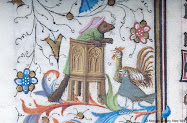So, today's adventures in archive-land involved my first visit to the British Library, which is much bigger and plusher than I was expecting. In my head, I'd imagined something along the lines of your basic university library writ large, and given the generally parlous state of funding for enterprises such as archives, museums and libraries, I also expected it would be a bit down-at-heel in the old design department. So I was pleasantly surprised at its 5 floors of glass and marble, recessed lighting, and finely curved staircases. In the reading rooms, the desks and chairs resemble something out of the business centre in an up-market hotel. The best bit, though, is the massive multistory atrium tower of bound manuscripts in a great cube of glass. (I'm not sure if these are purely for show or if this is part of the storage, but all the different coloured leather bindings and gold lettering make quite an impression. Talk about the bookcase of my dreams!)
Anyway, after jumping through the several hoops required to get a Reader's card, I repaired to the Manuscript room and spent the day with a couple of manuscripts from the 15thC (one of which was originally copied for Sir John Paston). They were written in a mixture of English and French /Anglo-Norman, so I was expecting to have to do some work deciphering them, but I had more trouble with the tiny script than with the actual language. Parts of one of them looked like some mad spiders had gotten loose in an inkpot. It took me a while to get my 'eye' in, and clearly, I need a lot more practice reading handwriting! It's odd, but I realised that I very rarely see handwritten text these days (even my own), because pretty much everything is done on computers. For about the first hour, I was freaking out a bit thinking I wouldn't be able to read a damned thing, even of the English texts, but it got better as I went along. And I do enjoy seeing all those marginal notations and doodles from various readers over the centuries ( if you did that now, I believe the BL staff would take you out and pillory you). There is also something very human and tangible about the way the handwriting goes in cycles, from being very neat at the start of a section to getting progressively rattier a few pages in. I can just imagine that the scribe getting a bit fed up towards the end of his working day and letting things go just a bit.
I'm writing this while I'm having dinner (at a classic pub called The Duke in the lovely old town of Richmond) and one of the many benefits of overseas travel just occurred to me as I was reading the menu. That is, at home we take great pride in 'our' wine industry, which is all well and good, but when you eat out, you rarely see many wines from other countries onthe winelist. And when you do, the most common import is Australian (and the odd Chilean wine, but usually of the cheap-and-cheerful rustic red variety). Tonight, my wine options included varieties from all over Europe, South Africa, South America, and even a cab sav from Lebanon (there was also the obligatory New Zealand sauvignon blanc, just to make me feel at home).
Friday, June 15, 2012
Subscribe to:
Post Comments (Atom)




3 comments:
Love the Duke. Good choice.
For variety, next time go the other way from TNA and check out the (variety) of pubs on Kew green. 'tis but a hop, step and a jump from the Archives at closing time!
Norfolk Arms is just a couple of blocks from the BL, and I love the food there. A blend between traditional pub food and tapas.
Sounds like a good start to your visit!
Thanks for the tips! I'm staying in Kew (a very nice B & B if anyone needs a recommendation for future reference) so I've checked out the Botanist already. Love the atmosphere of the working brewery, and the atmosphere was very convivial.
Post a Comment